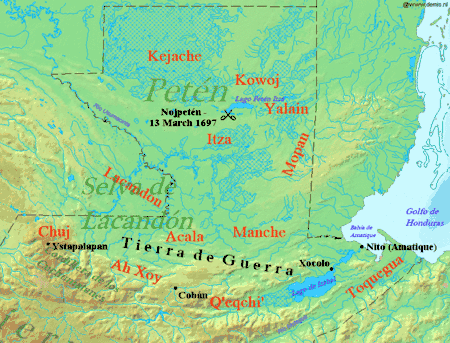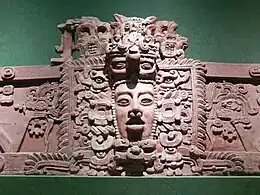Lakandon Chʼol
The Lakandon Chʼol were a former Chʼol-speaking Maya people inhabiting the Lacandon Jungle in what is now Chiapas in Mexico and the bordering regions of northwestern Guatemala,[1] along the tributaries of the upper Usumacinta River and the foothills of the Sierra de los Cuchumatanes.[2]

The Lakandon Chʼol at contact with the Spanish
The Lakandon Chʼol of the time of the Spanish conquest should not be confused with the modern Yucatec-speaking Lacandon people occupying the same region.[3] At the time of Spanish contact in the 16th century, the Lacandon Jungle was inhabited by Chʼol people referred to as Lakam Tun. This name was hispanicised, first to El Acantun, then to Lacantun and finally to Lacandon.[4] The main Lakandon village was situated on an island in Lake Miramar, also referred to as Lakam Tun by the inhabitants.[5] The Lakandons, together with their equally unconquered Itza enemies to the northeast, had an especially warlike reputation among the Spanish.[6]
Later history
| This article is part of a series on the |
| Maya civilization |
|---|
 |
|
| History |
| Preclassic Maya |
| Classic Maya collapse |
| Spanish conquest of the Maya |
|
|
Hernán Cortés first heard of the existence of the Lakandon when he was passing through Kejache territory in 1524, although he did not actually contact them.[7] During the 16th century, the Spanish colonial authorities in Verapaz, within the Captaincy General of Guatemala, complained that baptised Maya were fleeing colonial towns in order to find refuge among the independent Lakandon and their Manche Chʼol neighbours.[8] The first Spanish expedition against the Lakandons was carried out in 1559, commanded by Pedro Ramírez de Quiñones.[9]
At the end of the 16th century, under pressure from the advancing Spanish frontier, the Lakandon Chʼol abandoned Lakam Tun and withdrew deeper into the forest to the southeast where they founded a new town, Sakbʼajlan, within a wide curve of the Lacantún River.[10] The name of the town translated as "white jaguar". The Lakandons had two other settlements further east, called Map and Peta.[11]
During the course of the 17th century, the Lakandon Chʼol raided the Guatemalan Highlands to such an extent that it was considered unsafe to travel in the region surrounding San Mateo Ixtatán and Santa Eulalia in the Sierra de los Cuchumatanes,[12] within the colonial Corregimiento de Totonicapán y Huehuetenango administrative division.[13] In response, the colonial authorities placed garrisons in both towns in order to protect the local inhabitants against Lakandon raids, with limited success.[12] The Lakandon Chʼol traded with the colonial Maya towns of Cobán and Cahabón in Alta Verapaz, receiving quetzal feathers, copal, chile, cotton, salt and Spanish-produced iron tools in exchange for cacao and achiote.[14] From time to time the Spanish launched punitive military expeditions against the Lakandons to try to stabilise the northern frontier of the Guatemalan colony; the largest expeditions took place in 1685 and 1695.[15]
Conversion and resettlement
Franciscan friars Antonio Margil and Melchor López were active among the Lakandon and Manche Chʼol between 1692 and 1694; they eventually outstayed their welcome and were expelled by the Chʼol.[16] Most of the Lakandon Chʼol were forcibly relocated to the Huehuetenango area by the Spanish in the early 18th century. The resettled Lakandon Chʼol were soon absorbed into the local Maya populations there and ceased to exist as a separate ethnicity.[17] The last known Lakandon Chʼol were three Indians that were recorded as living in Santa Catarina Retalhuleu in 1769.[18]
See also
Notes
- Thompson 1938, pp. 586-587.
- Jones 1998, p. 112.
- Pons Sáez 1997, p. v. Eroza Solana 2006, p. 7.
- Pugh 2009, p. 369.
- Pons Sáez 1997, p. xii.
- Houwald 1984, p. 257. Vos 1980, 1996, pp. 15-16.
- Pons Sáez 1997, p. xiii.
- Lovell 2000, p. 415.
- Lovell 2005, pp. 78, 243n19.
- Vos 1980, 1996, p.15. Jones 2000, p. 362.
- Vos 1980, 1996, p.15.
- Lovell 2005, p. 82.
- Limón Aguirre p. 12.
- Caso Barrera and Aliphat 2007, pp. 49, 51.
- Lovell 2005, p. 181.
- Webre 2004, p. 11.
- Jones 2000, p. 365.
- Vos 1980, 1996, p. 17.
References
- Caso Barrera, Laura; Mario Aliphat (2007). J.P. Laporte; B. Arroyo; H. Mejía (eds.). "Relaciones de Verapaz y las Tierras Bajas Mayas Centrales en el siglo XVII" (PDF). XX Simposio de Investigaciones Arqueológicas en Guatemala, 2006 (in Spanish). Guatemala City, Guatemala: Museo Nacional de Arqueología y Etnología: 48–58. OCLC 173275417. Archived from the original (PDF) on 2013-10-17. Retrieved 2012-01-22.
- Eroza Solana; Enrique (2006). Lancandones. Pueblos indígenas del México contemporáneo (in Spanish). Mexico City, Mexico: Comisión Nacional para el Desarollo de los Pueblos Indígenas. ISBN 970-753-049-9. OCLC 71844580.
- Houwald, Götz von (1984). "Mapa y Descripción de la Montaña del Petén e Ytzá. Interpretación de un documento de los años un poco después de la conquista de Tayasal" (PDF). Indiana (in Spanish). Berlin, Germany: Ibero-Amerikanisches Institut (9). ISSN 0341-8642. OCLC 2452883. Retrieved 2013-10-25.
- Jones, Grant D. (1998). The Conquest of the Last Maya Kingdom. Stanford, California, USA: Stanford University Press. ISBN 9780804735223.
- Jones, Grant D. (2000). "The Lowland Maya, from the Conquest to the Present". In Richard E.W. Adams; Murdo J. Macleod (eds.). The Cambridge History of the Native Peoples of the Americas, Vol. II: Mesoamerica, part 2. Cambridge, UK: Cambridge University Press. pp. 346–391. ISBN 0-521-65204-9. OCLC 33359444.
- Limón Aguirre, Fernando (2008). "La ciudadanía del pueblo chuj en México: Una dialéctica negativa de identidades" (PDF) (in Spanish). San Cristóbal de Las Casas, Mexico: El Colegio de la Frontera Sur – Unidad San Cristóbal de Las Casas. Archived from the original (PDF) on 2012-04-02. Retrieved 2013-10-25.
- Lovell, W. George (2000). "The Highland Maya". In Richard E.W. Adams; Murdo J. Macleod (eds.). The Cambridge History of the Native Peoples of the Americas, Vol. II: Mesoamerica, part 2. Cambridge, UK: Cambridge University Press. pp. 392–444. ISBN 0-521-65204-9. OCLC 33359444.
- Lovell, W. George (2005). Conquest and Survival in Colonial Guatemala: A Historical Geography of the Cuchumatán Highlands, 1500–1821 (3rd ed.). Montreal, Canada: McGill-Queen's University Press. ISBN 0-7735-2741-9. OCLC 58051691.
- Pons Sáez, Nuria (1997). La Conquista del Lacandón (in Spanish). Mexico: Universidad Nacional Autónoma de México. ISBN 968-36-6150-5. OCLC 40857165.
- Pugh, Timothy W. (2009). "The Kowoj and the Lacandon: Migrations and Identities". In Prudence M. Rice; Don S. Rice (eds.). The Kowoj: identity, migration, and geopolitics in late postclassic Petén, Guatemala. Boulder, Colorado, US: University Press of Colorado. pp. 368–384. ISBN 978-0-87081-930-8. OCLC 225875268.
- Thompson, J. Eric S. (October–December 1938). "Sixteenth and Seventeenth Century Reports on the Chol Mayas". American Anthropologist. New Series. Wiley on behalf of the American Anthropological Association. 40 (4 (Part 1)): 584–604. doi:10.1525/aa.1938.40.4.02a00040. JSTOR 661615. (subscription required)
- Vos, Jan de (1996) [1980]. La paz de Dios y del Rey: La conquista de la Selva Lacandona (1525-1821) (in Spanish). Mexico City, Mexico: Secretaría de Educación y Cultura de Chiapas/Fondo de Cultura Económica. ISBN 968-16-3049-1. OCLC 20747634.
- Webre, Stephen (2004). "Política, evangelización y guerra: Fray Antonio Margil de Jesús y la frontera centroamericana, 1684–1706". VII Congreso Centroamericano de Historia, Universidad Nacional Autónoma de Honduras, Tegucigalpa, 19–23 July 2004 (in Spanish). San José, Costa Rica: Universidad de Costa Rica, Escuela de Historia. Archived from the original (DOC) on 2 November 2014. Retrieved 2012-12-09.